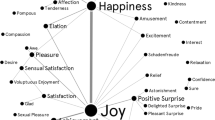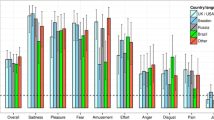Abstract
Several theorists have proposed that distinctions are needed between different positive emotional states, and that these discriminations may be particularly useful in the domain of vocal signals (Ekman, 1992b, Cognition and Emotion, 6, 169–200; Scherer, 1986, Psychological Bulletin, 99, 143–165). We report an investigation into the hypothesis that positive basic emotions have distinct vocal expressions (Ekman, 1992b, Cognition and Emotion, 6, 169–200). Non-verbal vocalisations are used that map onto five putative positive emotions: Achievement/Triumph, Amusement, Contentment, Sensual Pleasure, and Relief. Data from categorisation and rating tasks indicate that each vocal expression is accurately categorised and consistently rated as expressing the intended emotion. This pattern is replicated across two language groups. These data, we conclude, provide evidence for the existence of robustly recognisable expressions of distinct positive emotions.

Similar content being viewed by others
References
Adolphs, R., Tranel, D., Damasio, H., & Damasio, A. R. (1994). Impaired recognition of emotion in facial expressions following bilateral damage to the human amygdala. Nature, 372, 669–672.
Banse, R., & Scherer, K. R. (1996). Acoustic profiles in vocal emotion expression. Journal of Personality and Social Psychology, 70, 614–636.
Berridge, K. C. (2003). Pleasures of the brain. Brain and Cognition, 52, 106–128.
Calder, A. J., Keane, J., Manly, T., Sprengelmeyer, R., Scott, S., Nimmo-Smith, I., et al. (2003). Facial expression recognition across the adult life span. Neuropsychologia, 41, 195–202.
Cohen, J. D., McWhinney, B., Flatt, M., & Provost, J. (1993). A new graphic interactive environment for designing psychology experiments. Behavioral Research Methods, Instruments, and Computers, 25, 257–271.
Ekman, P. (1992a). Are there basic emotions? Psychological Review, 99, 550–553.
Ekman, P. (1992b). An argument for basic emotions. Cognition and Emotion, 6, 169–200.
Ekman, P. (1994). Strong evidence for universals in facial expressions: A reply to Russell's mistaken critique. Psychological Bulletin, 115, 268–287.
Ekman, P. (2003). Emotions revealed: Recognising faces and feelings to improve communication and emotional life. London: Weidenfeld and Nicolson.
Ekman, P., Levenson, R. W., & Friesen, W. V. (1983). Autonomic nervous system activity distinguishes among emotions. Science, 221, 1208–1210.
Ekman, P., Sorenson, E. R., & Friesen, W. V. (1969). Pan-cultural elements in facial displays of emotion. Science, 164, 86–88.
Elfenbein, H. A., & Ambady, N. (2002b). On the universality and cultural specificity of emotion recognition: A meta-analysis. Psychological Bulletin, 128, 203–235.
Elfenbein, H. A., & Ambady, N. (2003). When familiarity breeds accuracy: Cultural exposure and facial emotion recognition. Journal of Personality and Social Psychology, 85, 276–290.
Fredrickson, B. L. (1998). What good are positive emotions? Review of General Psychology, 2, 300–319.
Fried, I., Wilson, C. L., MacDonald, K. A., & Behnke, E. J. (1998). Electric current stimulates laughter. Nature, 391, 650.
Juslin, P. N., & Laukka, P. (2001). Impact of intended emotion intensity on cue utilization and decoding accuracy in vocal expression of emotion. Emotion, 1, 381–412.
Juslin, P. N., & Laukka, P. (2003). Communication of emotions in vocal expression and music performance: Different channels, same code? Psychological Bulletin, 129, 770–814.
Karama, S., Lecours, A. R., Leroux, J. M., Bourgouin, P., Beaudoin, G., Joubert, S., et al. (2002). Areas of brain activation in males and females during viewing of erotic film excerpts. Human Brain Mapping, 16, 1–13.
Matsumoto, D. (2002). Methodological requirements to test a possible in-group advantage in judging emotions across cultures: Comment on Elfenbein and Ambady (2002) and evidence. Psychological Bulletin, 128, 236–242.
Rodden, A., Wild, B., Erb, M., Titze, M., Ruch, W., & Grodd, W. (2001). Humour, laughter and exhilaration studied with functional Magnetic Resonance Imaging (fMRI). NeuroImage, 13, 466.
Russell, J. A. (1980). A circumplex model of affect. Journal of Personality and Social Psychology, 39, 1161–1178.
Scherer, K. R. (1986). Vocal affect expression: A review and a model for future research. Psychological Bulletin, 99, 143–165.
Scherer, K. R., Banse, R., & Wallbott, H. G. (2001). Emotion inferences from vocal expression correlate across languages and cultures. Journal of Cross Cultural Psychology, 32, 76–92.
Schröder, M. (2003). Experimental study of affect bursts. Speech Communication, 40, 99–116.
Wagner, H. L. (1993). On measuring performance in category judgement studies of nonverbal behavior. Journal of Nonverbal Behavior, 17, 3–28.
Young, A. W., Rowland, D., Calder, A. J., Etcoff, N. L., Seth, A., & Perrett, D. I. (1997). Facial expression megamix: Tests of dimensional and category accounts of emotion recognition. Cognition, 63, 271–313.
Author information
Authors and Affiliations
Corresponding author
Appendix A
Appendix A
Scenarios for emotions and dimensions.
Scenarios for putative positive emotions, and the dimensions arousal and valence .
Emotion | Scenario |
|---|---|
Achievement/Triumph | You get a phone call offering you a job you really want |
Amusement | You are being tickled and find it really funny |
Contentment | You are sitting on the beach watching the sunset |
Pleasure | Your boyfriend/girlfriend is touching you in a sensual way |
Relief | You thought you had lost your keys but find them again |
Arousal | Minimum: You are feeling sleepy |
Maximum: You are very awake and alert | |
Valence | Positive: You are having an ecstatic experience |
Negative: You are experiencing trauma or extreme fear |
Rights and permissions
About this article
Cite this article
Sauter, D.A., Scott, S.K. More than one kind of happiness: Can we recognize vocal expressions of different positive states?. Motiv Emot 31, 192–199 (2007). https://doi.org/10.1007/s11031-007-9065-x
Received:
Accepted:
Published:
Issue Date:
DOI: https://doi.org/10.1007/s11031-007-9065-x




